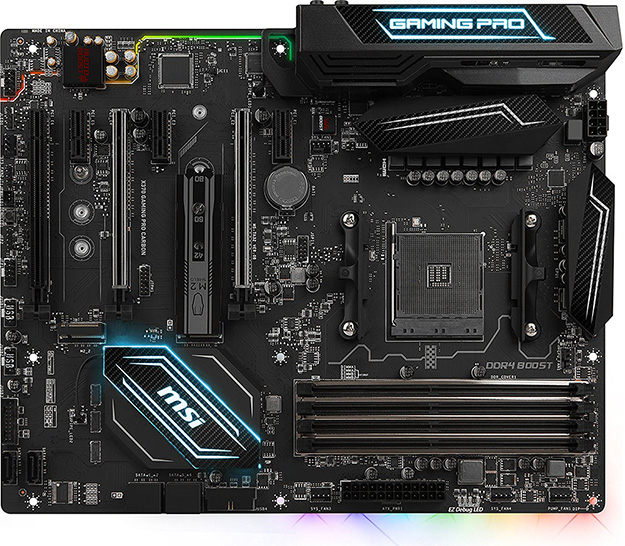AMD Ryzen Microcode Update To Improve DRAM Overclocking Flexibility And Virtualization Support
As much as we like what AMD has been able to accomplish with Ryzen, there have been some growing pains associated with its newest CPU architecture, which is not unexpected when introducing a brand new platform. The good news is AMD is not ignoring the situation—AMD has been working its motherboard partners on firmware updates, the latest of which addresses compatibility issues with higher frequency DRAM that falls outside of the JEDEC specifications (anything faster than 2,667MHz).
To be clear, AMD is not building custom BIOSes for motherboard manufactures, or at least not the final version that you might download from, say, Gigabyte or ASUS. Instead, AMD provides what is essentially the nucleus for the BIOS, which is referred to as AGESA (AMD Generic Encapsulated System Architecture). Motherboard makers take the core capabilities of AMD's AGESA updates and build on top of them with their own custom tweaks and optimizations.

Most current BIOSes for AM4 motherboards are based on AGESA version 1.0.0.4. That is about to change, as AMD is wrapping up beta testing on AGESA version 1.0.0.6, which is primarily focused on stabilizing overclocked DRAM (anything faster than DDR4-2667).
"We are now at the point where that testing can begin transitioning into release candidate and/or production BIOSes for you to download. Depending on the QA/testing practices of your motherboard vendor, full BIOSes based on this code could be available for your motherboard starting in mid to late June. Some customers may already be in luck, however, as there are motherboards—like my Gigabyte GA-AX370-Gaming5 and ASUS Crosshair VI—that already have public betas," AMD's Robert Hallock states in a blog post.
Though it is an incremental update, AGESA 1.0.0.6 adds more than two dozen new parameters to improve the compatibility of overclocked DRAM. If you've had trouble booting your Ryzen rig with faster clocked RAM, upcoming BIOS updates based on AMD's latest microcode should help the situation.
Beyond the focus on overclocked memory, AGESA 1.0.0.6 beefs up Ryzen's virtualization capabilities by adding fresh support for PCi Express Access Control Services (ACS).
"ACS primarily enables support for manual assignment of PCIe graphics cards within logical containers called 'IOMMU groups'. The hardware resources of an IOMMU group can then be dedicated to a virtual machine," Hallock explains.
Where this pays dividends is for users who want 3D accelerated graphics inside of a virtual machine. Using ACS, it is possible to split a dual GPU system that has a host Linux OS and a Windows VM, both with a dedicated graphics card. The virtual machine can access all of the capabilities of the dedicated GPU, with AMD claiming that games running inside a VM will perform at near the same level of performance as outside of a VM.
To be clear, AMD is not building custom BIOSes for motherboard manufactures, or at least not the final version that you might download from, say, Gigabyte or ASUS. Instead, AMD provides what is essentially the nucleus for the BIOS, which is referred to as AGESA (AMD Generic Encapsulated System Architecture). Motherboard makers take the core capabilities of AMD's AGESA updates and build on top of them with their own custom tweaks and optimizations.

Most current BIOSes for AM4 motherboards are based on AGESA version 1.0.0.4. That is about to change, as AMD is wrapping up beta testing on AGESA version 1.0.0.6, which is primarily focused on stabilizing overclocked DRAM (anything faster than DDR4-2667).
"We are now at the point where that testing can begin transitioning into release candidate and/or production BIOSes for you to download. Depending on the QA/testing practices of your motherboard vendor, full BIOSes based on this code could be available for your motherboard starting in mid to late June. Some customers may already be in luck, however, as there are motherboards—like my Gigabyte GA-AX370-Gaming5 and ASUS Crosshair VI—that already have public betas," AMD's Robert Hallock states in a blog post.
Though it is an incremental update, AGESA 1.0.0.6 adds more than two dozen new parameters to improve the compatibility of overclocked DRAM. If you've had trouble booting your Ryzen rig with faster clocked RAM, upcoming BIOS updates based on AMD's latest microcode should help the situation.
Beyond the focus on overclocked memory, AGESA 1.0.0.6 beefs up Ryzen's virtualization capabilities by adding fresh support for PCi Express Access Control Services (ACS).
"ACS primarily enables support for manual assignment of PCIe graphics cards within logical containers called 'IOMMU groups'. The hardware resources of an IOMMU group can then be dedicated to a virtual machine," Hallock explains.
Where this pays dividends is for users who want 3D accelerated graphics inside of a virtual machine. Using ACS, it is possible to split a dual GPU system that has a host Linux OS and a Windows VM, both with a dedicated graphics card. The virtual machine can access all of the capabilities of the dedicated GPU, with AMD claiming that games running inside a VM will perform at near the same level of performance as outside of a VM.

